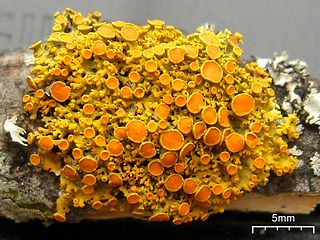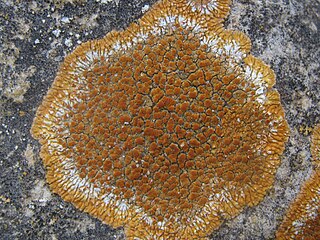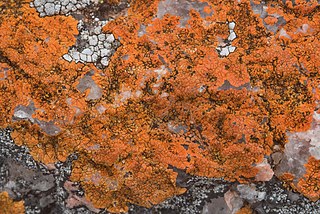Neobrownliella brownlieae is a species of saxicolous (rock-dwelling), crustose lichen in the family Teloschistaceae. It is widely distributed in Australia.

Lecanora muralis(Protoparmeliopsis muralis) is a waxy looking, pale yellowish green crustose lichen that usually grows in rosettes radiating from a center (placodioid) filled with disc-like yellowish-tan fruiting bodies (apothecia). It grows all over the world. It is extremely variable in its characteristics as a single taxon, and may represent a complex of species. The fruiting body parts have rims of tissue similar to that of the main nonfruiting body (thallus), which is called being lecanorine. It is paler and greener than L. mellea, and more yellow than L. sierrae. In California, it may be the most common member of the Lecanora genus found growing on rocks (saxicolous).
Hypogymnia congesta is a rare species of foliose lichen in the family Parmeliaceae. Found in China, it was formally described as a new species in 2003. The lichen grows on the bark and wood of conifers and bamboo. Hypogymnia congesta has a brown to brownish-grey foliose thallus measuring up to 8 cm (3.1 in) long or broad, with a cartilage-like texture. The lichen is chemically distinct, containing physodic acid and virensic acid; the latter substance is otherwise unknown from genus Hypogymnia.
Punctelia purpurascens is a species of foliose lichen in the family Parmeliaceae. Found in Brazil, it was formally described as a new species in 2007 by lichenologists Marcelo Marcelli and Luciana da Silva Canêz. The type specimen was collected in the municipality of Vicara in the southern Brazilian state of Rio Grande do Sul. There it was found growing on a basaltic rock in an open field. The specific epithet purpurascens refers to the unusual K+ purple reaction of the medulla.
Punctelia jujensis is a species of foliose lichen in the family Parmeliaceae. It is found in Argentina and Brazil.
Lecanora panticapaensis is a species of saxicolous (rock-dwelling), crustose lichen in the family Lecanoraceae. It occurs in a single locality in Dnipropetrovsk Oblast, Ukraine, where it grows on the vertical surfaces of black schist beside a river.
Caloplaca kedrovopadensis is a little-known species of crustose lichen in the family Teloschistaceae. It is only found in the Kedrovaya Pad Nature Reserve in the Russian Far East, and on the Jiri Mountain of South Korea. The lichen has been recorded growing on rocks and on bark.
Lecanora ussuriensis is a species of saxicolous (rock-dwelling) lichen in the family Lecanoraceae. It is found in single localities in the Primorsky Krai region of the Russian Far East, as well as in Japan.
Opegrapha verseghyklarae is a little-known species of lichenicolous (lichen-eating) fungus in the family Teloschistaceae. It is found in the Russian Far East, where it grows on the thalli and apothecia of the crustose lichen Ochrolechia pallescens.
Lecidella mandshurica is a species of corticolous (bark-dwelling), crustose lichen in the family Lecanoraceae. It is found in the Russian Far East, South Korea, and China.
Lecanora lojkahugoi is a species of saxicolous (rock-dwelling) crustose lichen in the family Lecanoraceae. It is found in the Russian Far East and in South Korea.
Biatora oxneri is a species of corticolous (bark-dwelling) lichen in the family Ramalinaceae. It is found in the Russian Far East and in South Korea.

Oxneria is a genus of foliose lichens in the family Teloschistaceae. It has four species. The genus was circumscribed in 2003 by Sergey Kondratyuk and Ingvar Kärnefelt, with Oxneria alfredii assigned as the type species.
Dibaeis yurii is a little-known species of terricolous (ground-dwelling) lichen in the family Icmadophilaceae. It is found in the Russian Far East and in South Korea.
Gallowayella aphrodites is a species of corticolous (bark-dwelling), foliose (leafy) lichen in the family Teloschistaceae. It is found in the Mediterranean countries Greece, Cyprus, and Italy. Characteristics of the lichen include its small thallus, the disposition of the rhizines on the thallus undersurface, and the lack of vegetative propagules.

Gallowayella hasseana, the poplar sunburst lichen, is a species of corticolous (bark-dwelling), crustose lichen in the family Teloschistaceae. It occurs in North America.
Imshaugia pyxiniformis is a rare species of corticolous (bark-dwelling), foliose lichen in the family Parmeliaceae. It is only known to occur at its type locality in the North Region of Brazil. Characteristics of the lichen include its narrow, incised lobes, lack of vegetative propagules, its pale lower cortex, and presence of the substance lichexanthone.
Opeltiella is a genus of lichen-forming fungi in the family Candelariaceae. The genus, established by Sergey Kondratyuk in 2020, has four species. It is differentiated from the similar genus Candelaria by its unique features such as eight-spored asci and absence of a lower cortical layer and true rhizines. The genus is characterised by its areolate to more or less squamulose or foliose thallus and the unique chemical substances it contains, such as calycin, pulvinic and vulpinic acids, and pulvinic acid lactone.

Variospora flavescens is a species of saxicolous (rock-dwelling), crustose lichen in the family Teloschistaceae. It is a common, widely distributed species and has been recorded in Africa, Asia, Europe, and Macaronesia.

Fulgogasparrea appressa is a species of saxicolous (rock-dwelling), crustose lichen in the family Teloschistaceae. It has a widespread distribution in western Mexico, including Baja California. It is characterized by its vibrant colors, unique shape, and specific habitat preferences.




